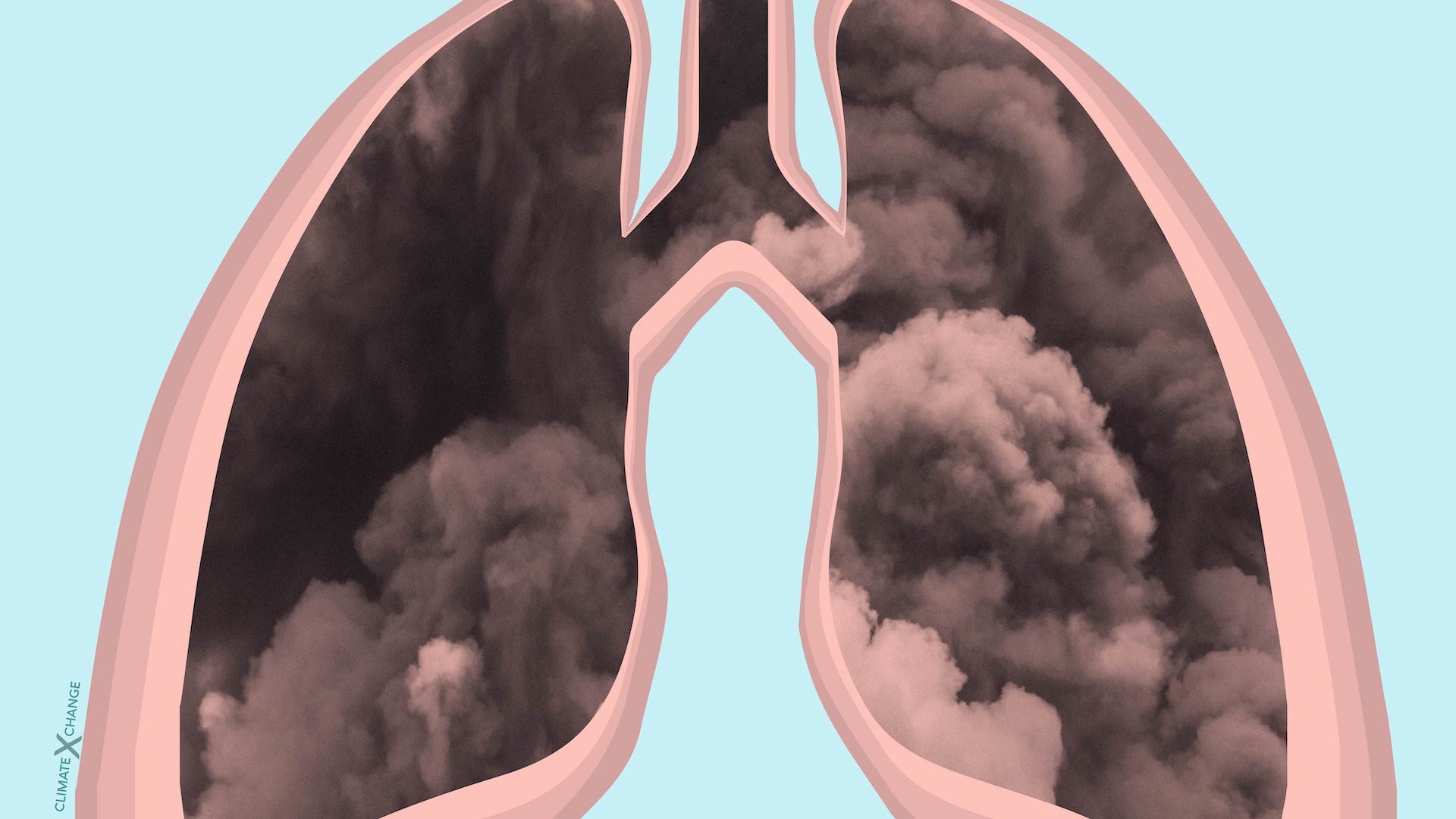The coronavirus crisis has completely transformed life across the globe. Already, COVID-19 infections span across six continents and cases are confirmed in almost every country, with the virus yet to peak in most. While the disease has affected the lives of millions, experts warn that older individuals and those with pre-existing conditions are the most at risk of serious complications from the virus
Now, many are also drawing conclusions between exposure to air pollution and coronavirus severity. Air pollution can both cause and worsen respiratory and cardiovascular issues — the same types of pre-existing conditions that medical experts warn have led to the worst cases of COVID-19.
The coronavirus is extremely recent and therefore, extensive data of its impacts on different demographics is still lacking. But by looking at previous viral epidemics and using some preliminary data, experts are already drawing a connection between exposure to air pollution and the severity, or mortality rate, of coronavirus cases.
These are incredibly difficult and stressful times, so be mindful to take care of your physical and mental health as you are able. Staying informed, and keeping a clear head is critically important. Here are some things you can do to stay healthy, and remember to check in on loved ones, and neighbors.
How does air pollution harm human health?
There is extensive research proving that air pollution, and those who are exposed to larger concentrations of it, are more at risk of developing certain illnesses, and increased rates of mortality and morbidity. In fact, the World Health Organization (WHO) estimates that globally, 7 million people die every year from causes directly attributed to air pollution.
Fine particulate matter, or PM 2.5., can be found in a wide variety of pollution sources, but the largest quantities come from transportation emissions, heat and power generation, industrial facilities, and waste sites. PM 2.5 are extremely small particles, tiny enough to bypass the nose and throat, make their way into the lungs, and cross into the bloodstream, making them especially harmful to human health. Individuals living or working close to these sources of pollutants are at much larger risk of developing pollution-related health problems.
Some of the most common and long-term problems stemming from pollution exposure include asthma, reduced lung capacity and lung cancer, increased susceptibility to respiratory illnesses, such as pneumonia and chronic bronchitis, and cardiovascular morbidity and illnesses, such as heart attacks.
There are many other diseases and health issues that can also be aggravated by contact with dirty air. One study in Ontario, Canada, found that residents living closer to highways, and therefore facing higher exposure to fine particulate matter from vehicles, were more likely to suffer from dementia.
A report by the Health Effects Institute found that “fine particle air pollution is the largest environmental risk factor worldwide, responsible for a substantially larger number of attributable deaths than other more well-known behavioral risk factors such as alcohol consumption, physical inactivity, or high sodium intake,” emphasizing how serious of a health risk air pollution is.
Research points to a clear connection between air pollution and health risks — and many of these health risks cause the same pre-existing conditions that experts have warned make individuals more vulnerable to coronavirus. This has led scientists to draw connections between air pollution and COVID-19.
Coronavirus harms those already at risk — and air pollution is an immense risk factor
“It’s not that air pollution is going to make coronavirus a more effective pathogen, but that people who are already suffering from respiratory illnesses, both acute and chronic, if they get infected, are likely to get sicker, because their lungs are already compromised,” Craig Slatin, Professor Emeritus at University of Massachusetts Lowell, told Climate XChange.
The WHO has found that individuals suffering from asthma, diabetes, and heart disease are the most at risk of fatality from the virus — these health issues can all be caused or worsened from air pollution exposure.
A new report published by the European Public Health Alliance (EPHA) finds that individuals living in cities with high rates of air pollution are more at risk from COVID-19, describing how doctors are starting to link higher fatality rates to those who have pre-existing conditions brought on by air pollution, as they experience more and more cases and begin to see patterns.
Sara De Matteis from Cagliari University, Italy, who is also a member of the EPHA, says that “patients with chronic lung and heart conditions caused or worsened by long-term exposure to air pollution are less able to fight off lung infections and more likely to die. This is likely also the case for COVID-19.”
Similarly, a study just released by the Harvard University T.H. Chan School of Public Health finds that individuals in the United States exposed to just “1 μg/m3 in PM2.5 is associated with a 15% increase in the COVID-19 death rate.” If the average rate of particulate matter in New York City, the area in the U.S. hit the hardest by the coronavirus, had been lowered by just a single unit, the Harvard study finds that there would most likely have been 248 fewer COVID-19 deaths.
Individuals who have been exposed to more air pollution are always more at risk for respiratory illnesses — this is certainly not a new phenomenon.
“There is certainly a link between chronic lung conditions and the mortality rate of COVID-19, and there is also evidence that increasing levels of air pollution can lead to higher risks of developing chronic lung conditions, especially PM2.5. So logically there is a connection here,” Dr. Dingsheng Li, a professor at the University of Nevada, told Climate XChange.
Outbreaks in the past have disproportionately impacted those with more exposure to air pollution. For example, a study on the SARS (Severe Acute Respiratory Syndrome) outbreak, which infected nearly 8,000 people in the early 2000’s, found that individuals living in areas with high air pollution were twice as likely to die from the virus.
With the coronavirus, these linked effects may be even worse than in the past, because air pollution is the harshest for the same demographic that is most vulnerable to this particular coronavirus: the elderly.
A strain on overburdened communities
The elderly are not the only demographic most at risk to the health effects caused by air pollution. In fact, environmental justice communities, and those already living with disproportionate burdens of air pollution, are also feeling the most severe economic and health impacts brought on by this pandemic.
Studies have shown that around the globe, people earning a low-income are far more likely to live in areas that have high exposure to air pollution, and therefore face the worst health consequences that come with it.
People who are housing insecure and individuals experiencing homelesness are also more at risk from heavy air pollution: “In places where air pollution is a routine problem, we have to pay particular attention to individuals who may be more exposed or vulnerable than others to polluted air such as [those experiencing homelessness], those who don’t have air filtration in their homes, or those whose health is already compromised,” says Dr. Aaron Bernstein, the interim director of Harvard University’s Center for Climate, Health, and the Global Environment at the Harvard T.H. Chan School of Public Health.
In the United States, black and brown Americans are disproportionately overburdened by exposure to pollution and related environmental risks. One study found that “on average, African Americans and Latinos breathe in about 40 percent more particulate matter from cars, trucks and buses than white Californians.”
“Especially in the summertime, the heat makes the smog more intense. There are mornings when they say, ‘don’t go outside, stay inside,’ and that shouldn’t be happening. People should be safe when they’re walking down the street, and the fact that it’s all because of the heat, and the air pollution that’s causing all of this, we need to do something about that,” says Maxine, who lives in a Latinx community near a busy highway in Los Angeles.
While many communities exposed to air pollution live near large highways and truck routes, industrial plants and waste sites are also a huge cause of increased air pollution intake; and African Americans in the United States are far more likely to live near a power plant than white Americans. The NAACP found that “68% of African Americans live within 30 miles of a coal-fired power plant,” which could be a driver of unequal health outcomes across the U.S.
Why are minority communities more likely to be exposed to air pollution?
Black and brown communities are not exposed to increased air pollution by chance. Institutional racism in the United States, that has been codified by law, has forced these groups into areas with more air pollution.
One of these policies is redlining, the process of delineating certain areas on a map based on race or ethnicity, and denying these areas certain goods or services. This policy was popular in the early twentieth-century as a way to determine which areas within certain cities were the best for investments, which areas qualified for mortgages, and which areas received loans. Although the policy was outlawed in the 1960s, the racist effects of redlining are still apparent today, and have contributed to a greater exposure to air pollution for minorities. Because businesses did not want to invest in communities deemed to be “high risk” by redlining — predominantly minority communities — undesirable industries were built in these areas, such as power plants or high-polluting factories.
Today, data proves that redlining maps drawn in the 1930s and 1940s “are still predictive of not only who lives in a neighborhood, but also what kind of health problems they are experiencing,” says Anthony Nardone, a medical student in the UC Berkeley-UCSF Joint Medical Program who conducted a study which shows that residents in areas that were once deemed “high risk” are today more than twice as likely to be sent to the hospital for health issues related to air pollution.
There is also a serious disparity between those who are reaping the benefits from polluting materials, and those who are harmed the most. Pollution exists because there is a demand for the products and services created by power plants, fossil fuels, and transportation, among other polluting materials. A 2019 study done by PNAS found that “air pollution is disproportionately caused by white Americans’ consumption of goods and services, but disproportionately inhaled by black and Hispanic Americans.”
How the coronavirus multiplies health risks
Minority and low-income communities are already at a greater risk for health issues due to air pollution, and the novel coronavirus multiplies that risk. Low-income communities will also be disproportionately exposed to the virus — these communities rely much more on public transportation, are more likely to work hourly-wage jobs, and often live in closer quarters.
Many of the economic effects of the current crisis are also being felt hardest by those earning low-wages, or living in poverty. The hospitality sector, which includes restaurants and tourism industries, has all but been completely shut down to prevent COVID-19 from spreading too quickly. However, according to the Bureau of Labor Statistics, workers in this sector make an average annual wage of less than $30,000 (including tips), while the average annual wage for an American is $47,000.
“People with low incomes will be hardest-hit by social-distancing measures, and most likely to have the chronic health conditions that increase their risk of severe infections.” says Ed Yong of The Atlantic.
Not only are low-income communities most vulnerable to the health effects of the coronavirus, but they are also most at risk to the economic effects. Each of these risks has the potential to worsen the other, and shows how coronavirus has highlighted some of the worst injustices already prevalent in our society.
What can we learn from these lessons of inequality?
The coronavirus is not a stand-alone public health crisis. Experts have predicted that similar public health threats will happen with more and more frequency in the coming years. Coronavirus has exposed some of the overlapping vulnerabilities that certain communities face in times of crisis. This will not be the last time these communities face such threats.
The threat of climate change brings with it many similar disproportionate effects to, in many cases, the same communities that have been hit the hardest by coronavirus. Although emissions have recently decreased as industries shut down and transportation halts in response to COVID-19, this will not be a long-term effect, and the minute the threat of coronavirus has resided, it is likely that emissions will begin to increase at the same rate as before, if not faster to make up for lost production time.
We must use the knowledge and lessons learned from the coronavirus pandemic, not only to better prepare ourselves for the climate crisis, but to protect the communities who are the most exposed to overlapping risks. This means supporting and passing better climate policy that will reduce air pollution, for example, but doing so in a way that ensures environmental justice for all groups.
“Science tells us that epidemics like Covid-19 will occur with increasing frequency,” says EPHA Acting Secretary General Sascha Marschang, adding, “once this crisis is over, policymakers should speed up measures to get dirty vehicles off our roads… cleaning up the streets is a basic investment for a healthier future.”
This means supporting policies that provide housing justice and racial equity, such as providing down-payment assistance for first time home-buyers or incentivizing investments in minority communities. It also means pushing for smart climate policy, such as carbon pollution pricing, that will help to significantly reduce air pollution and protect at risk communities. Climate XChange’s research found that the carbon pricing policy in California has resulted in almost five times the health and climate benefits than the cost of the program, and has benefited at risk communities in doing so.
The revenue generated through carbon pricing can be specifically allocated to overburdened and disproportionately impacted communities, through rebates, or investments into clean energy and clean transportation access projects. This can be a critical component of a just transition to the clean economy of the future, and could also alleviate much of the overlapping public health and economic pressure many Americans face today.
Individuals who have had greater exposure to air pollution are certainly more at risk to the most severe effects of COVID-19, and systems must do everything they can to support these communities. While many of the worst effects of this crisis are already happening and cannot be prevented, understanding that similar crises will disproportionately affect the same populations in the future gives us the opportunity to pass smart legislation and policy that will protect these communities and will help cultivate a safer, healthier planet for us all.








